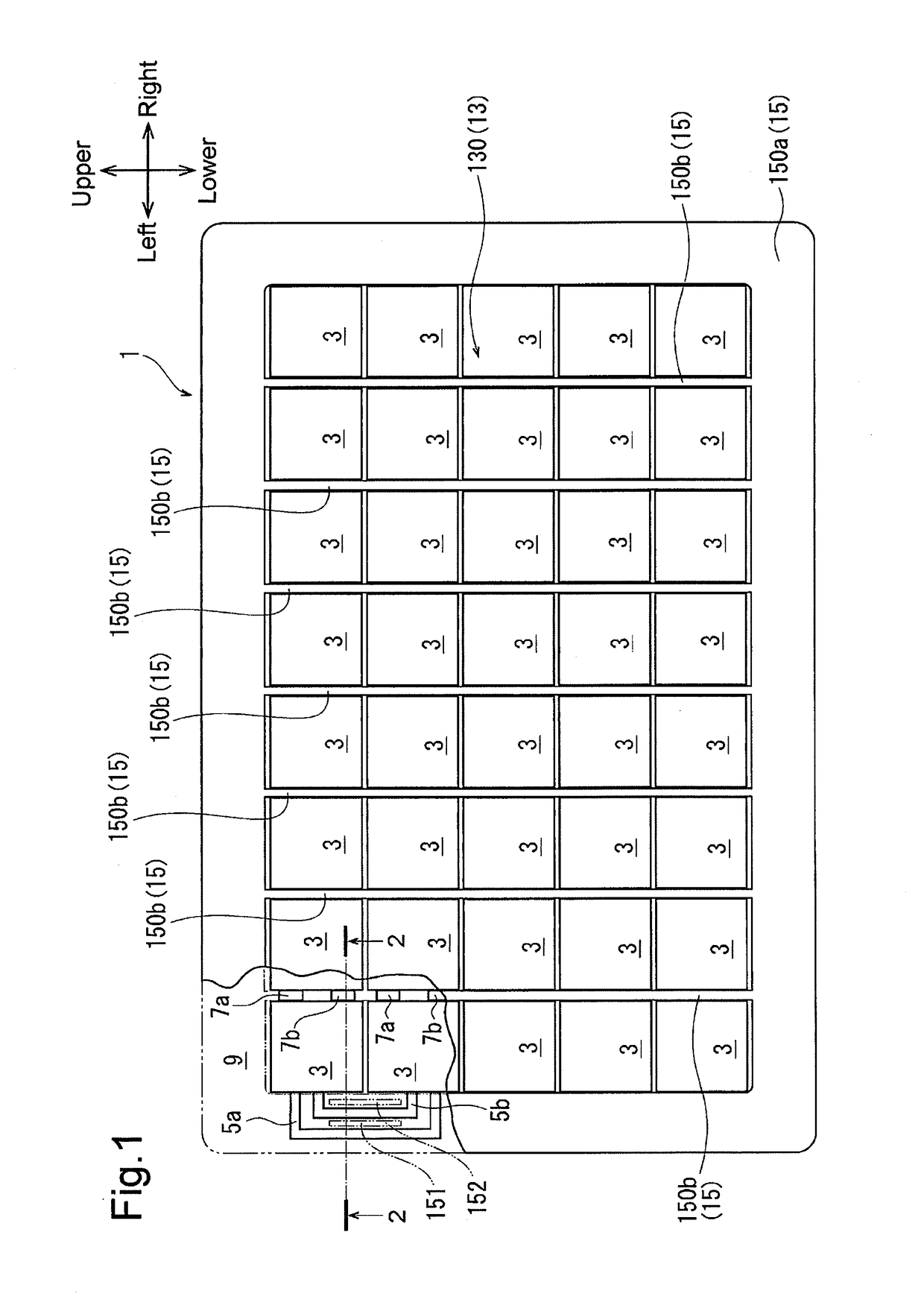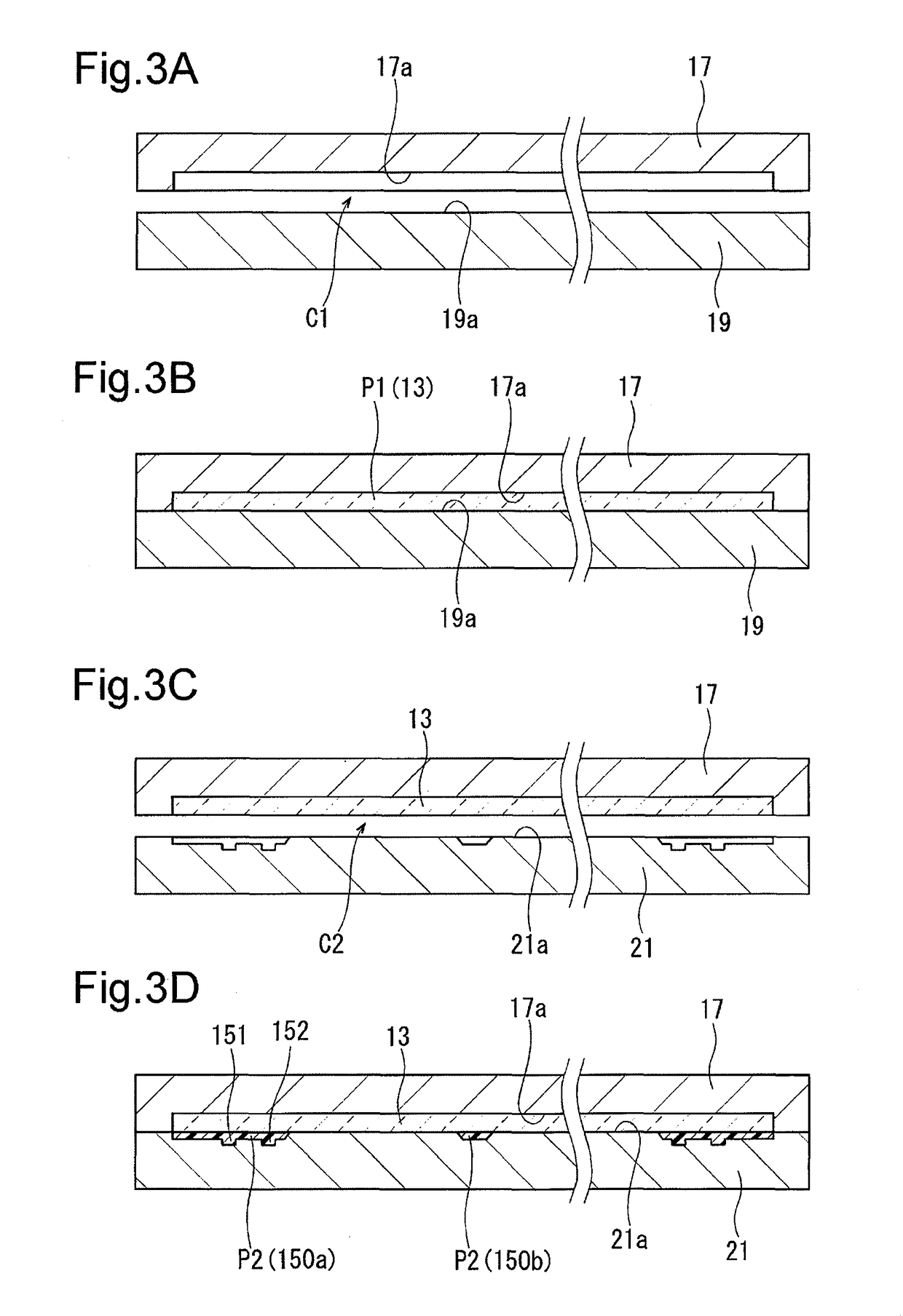Solar panel
a solar panel and solar panel technology, applied in the field of solar panels, can solve the problems of increasing the manufacturing cost of the protection plate, adversely affecting the aesthetic appeal, and increasing the manufacturing cost of the solar panel, so as to improve the aesthetic appeal and reduce the manufacturing cos
- Summary
- Abstract
- Description
- Claims
- Application Information
AI Technical Summary
Benefits of technology
Problems solved by technology
Method used
Image
Examples
first embodiment
[0015]As shown in FIGS. 1 and 2, a solar panel of the first embodiment includes a protection plate 1, photovoltaic battery cells 3, tab wires 5a and 5b, interconnectors 7a and 7b, an encapsulant 9, and a back panel 11. The tab wires 5a and 5b and the interconnectors 7a and 7b correspond to conductive members. The back panel 11 corresponds to a back cover. To facilitate understanding, the protection plate 1 is not shown in the portion illustrated by broken lines in FIG. 1. The frame of reference for the description hereafter is indicated by the arrows showing the upper, lower, left, and right directions of the solar panel in FIG. 1 and the arrows showing the left and right directions of the solar panel in FIGS. 2, 6, and 7 in correspondence with FIG. 1. The directions of the solar panel are irrelevant to the directions when using the solar panel.
[0016]The protection plate 1 includes a transparent plate 13, which is translucent from a front surface 13a to a rear surface 13b, and a bla...
second embodiment
[0047]As shown in FIG. 6, a solar panel of the second embodiment includes a wall 153. The wall 153 is integrated with the body 150a of the shield 15 together with the ribs 151 and 152. The wall 153, which has the form of a frame, extends from the rear surface 15b of the body 150a toward the encapsulant 9 to surround the encapsulant 9 from the outside. The third molding surface 21a of the third molding die 21 includes a recess corresponding to the wall 153 to simultaneously form the wall 153 and the body 150a.
[0048]In the solar panel, when the group of photovoltaic battery cells (photovoltaic battery cells 3, tab wires 5a and 5b, and interconnectors 7a and 7b) encapsulated by the encapsulant 9 are arranged between the protection plate 1 and the back panel 11, the wall 153 abuts against the back panel 11. The remaining structure of the solar panel is the same as the solar panel of the first embodiment. Like or same reference numerals are given to those components that are the same as...
third embodiment
[0050]As shown in FIG. 7, a solar panel of the third embodiment includes a first recess 131 and second recesses 132 that are formed on the rear surface 13b of the transparent plate 13, which differs from the solar panel of the first embodiment. In the solar panel of the third embodiment, the body 150a of the shield 15 does not include the ribs 151 and 152. FIG. 7 shows one of the second recesses 132.
[0051]Parts of the rear surface 13b are respectively recessed toward the front surface 13a to form the first recess 131 and the second recesses 132. The first recess 131, which has the form of a frame, is recessed to surround the group of the opposing portions 130. The second recesses 132 are located at the inner side of the first recess 131 and are continuous with the upper side and lower side of the first recess 131. The second molding surface 19a of the second molding die 19 includes projections corresponding to the first recess 131 and the second recesses 132 to simultaneously form t...
PUM
 Login to View More
Login to View More Abstract
Description
Claims
Application Information
 Login to View More
Login to View More - R&D
- Intellectual Property
- Life Sciences
- Materials
- Tech Scout
- Unparalleled Data Quality
- Higher Quality Content
- 60% Fewer Hallucinations
Browse by: Latest US Patents, China's latest patents, Technical Efficacy Thesaurus, Application Domain, Technology Topic, Popular Technical Reports.
© 2025 PatSnap. All rights reserved.Legal|Privacy policy|Modern Slavery Act Transparency Statement|Sitemap|About US| Contact US: help@patsnap.com



